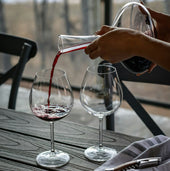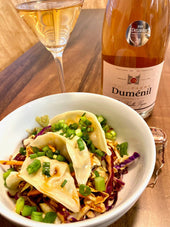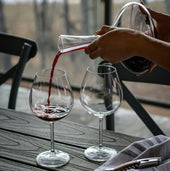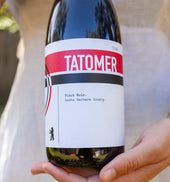
Lesser Known, But Stars At Home

Dive into Plume Ridge Bottle Shop’s cellars and you’ll find a number of hidden gem varietals that are beloved in their growing region and worth tasting. For whatever reason, these grape varietals and the wines made from them have not yet received the fandom of recent wine pop stars such as Pinot Grigio, Shiraz and Rosé. Fame is on the event horizon…as many of these varieties grace the wine list at top restaurants. To know these wines is to love them as the locals do.
Assyrtiko: (ah-seer-tiko) If you don’t have the drachmas to visit the Greek isles, you could take a virtual trip there by enjoying a bottle of Assyrtiko. Both affordable and eminently approachable, this crisp light white wine boasts high acidity, notes of citrus and apple or pear, and a salinity that makes it a perfect pairing for shellfish (because, what else could you possibly want to enjoy on a Greek island?) Grown primarily on Santorini (island of Mama Mia fame) the grape’s ability to sustain high acidity in a hot climate has winemakers experimenting with it in other regions, especially as the industry begins to feel the effects of climate change. Shop Plume Ridge’s Assyrtiko selections.
Blaufränkisch: (blauw-frank-keesh) This red austro-hungarian grape varietal derives part of its name from the medieval term Fränkisch, referring to the kingdom that encompassed northern France, Belgium and Western Germany from the 3rd century to the time of Charles the Great. Fränkisch grapes were of the highest quality. Blaufränkisch has been renowned in the region since the time of Napoleon, who admired the Hungarian version grown in Sopron. (Local folklore attributes the wine’s name to the color of the oxidized copper coins French soldiers used to purchase it.) Blaufränkisch is still grown primarily in Hungary and Austria, especially around Lake Neusiedl, which straddles the border between the two countries. Replete with zippy black fruit flavors, this affordable, inky-red wine boasts medium tannins and is very food-friendly. Pair Blaufränkisch with any Austrian or Hungarian regional fare, such as smoked sausage, spaetzle, wienerschnitzel or even grilled meat off the backyard BBQ. Shop Plume Ridge’s Glatzer Carnuntum Blaufränkisch.
Grüner Veltliner: (grew-ner felt-lee-ner) Another ümlaut-laden Austrian varietal, this white wine is so versatile that it can be made in any style from full-bodied to sparkling. Boasting both apple-pear and herbaceous flavors with a flinty finish, GruVe (as some have it) has enough acidity to lay down in a cellar or stand up to an excellent Chardonnay. While little-known here in the states, Grüner Veltliner is the most common white wine varietal in its home country of Austria, where it is grown along the Danube river around Vienna. Highly palatable GruVe is offered in most Austrian restaurants and can also be found in the Heuriger taverns where local winemakers serve their new wines under special license. Pair with light meats and seafood, or enjoy it with seasonal vegetables such as steamed artichokes or asparagus. Shop Plume Ridge’s Hiedler Osterreich Gruner Veltliner.
Sémillon: (sem-ee-yawn) To call this grape lesser-known is a bit of a misnomer. Most wine drinkers have enjoyed a White Bordeaux—a blend of Sémillon and Sauvignon Blanc—or a Sem-Chard blend from Australia. This Bordeaux native is grown throughout southwest France and in Australia, primarily in the Hunter Valley region, where it is produced as a single-varietal wine. Single varietal Sémillons can handle oak and have flavor notes of lemon, beeswax and peach. They pair well with fish and light meats. In wine blends, Sémillon provides the body and substance to round out the acidity of its partner grapes. White Bordeaux, whether light and fruity or rich and creamy, pairs well with food flavors of basil, avocado, lime or garlic.
Sémillon is also the primary grape in Sauternes, where it achieves mythical status as Bordeaux’s famous dessert wine. The wine’s zesty acidity, hint of residual sugar and botrytis-ey nutty notes has made Sauternes a favorite beverage of francophiles dating back to Thomas Jefferson. Sauternes is often paired with dessert, but is also famously combined with foie gras. Interestingly, Sauternes are the longest-lived wines, with the potential to age up to 100 years. Shop Plume Ridge’s Sémillon selections.
Tempranillo: (temp-rah-nee-oh) The Tempranillo grape is the top varietal grown in Spain, but it is better known for the Rioja wine in which it is the star ingredient. In fact, Tempranillo is the world’s 4th most popular grape variety, often blended with Grenache and Carignan (Garancha and Mazuelo) in Spain. There are 4 main styles of Rioja: the young and fruity unoaked Joven style, and the more complex, oaked and increasingly-aged Crianza, Rezerva and Gran Rezerva. Portugal is the second largest producer of Tempranillo, where it is used to make both table wines and Port. Recently, Australian winemakers have been experimenting with the grape. Its heat tolerance and early ripening make it ideal for the McLaren Vale and Victoria regions down under.
A thick-skinned black grape, Tempranillo grows well at higher elevations and thrives on hot days and cool nights. Younger Tempranillos have flavors of cherry, raspberry, vanilla and coconut, and pair well with pasta and other tomato-based fare. Aged Tempranillos develop fig, cedar, tobacco and dill notes that can stand up to bold meals featuring steak or lamb. The unique characteristics of aged Tempranillos comes from its contact with American Oak—a barreling tradition that began in the 16th century as a result of Spanish colonialism. Shop Plume Ridge’s Tempranillo selections.
 Patty Lyn Tweten is a writer, graphic designer and Pinot Noir vineyard owner. Working exclusively in the wine industry, her writing inspiration comes from visual design work and her own front yard. Website Facebook Instagram Linkedin
Patty Lyn Tweten is a writer, graphic designer and Pinot Noir vineyard owner. Working exclusively in the wine industry, her writing inspiration comes from visual design work and her own front yard. Website Facebook Instagram Linkedin


















































